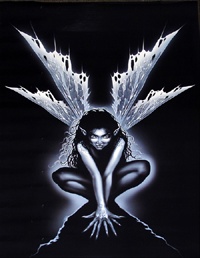 ‘Tis the season for that sweetest and most Canadian of non-timber forest products- it’s maple syrup time in the Vancouver Island bush! Many people associate maple syrup with the sugar maple (Acer saccharum) that grows in eastern Canada, and for good reason. Quebec produces most of the world’s supply of the sweet stuff (with Ontario, New Brunswick and Nova Scotia pitching in modestly as well), for a total of over 25 million liters (L) per year. But hobby and commercial maple syrup tapping on Vancouver Island is growing, and an industry based on our regional bigleaf maple (Acer macrophyllum) is emerging. Its syrup is darker and has a unique flavour which has been described as more robust than that of sugar maple.
‘Tis the season for that sweetest and most Canadian of non-timber forest products- it’s maple syrup time in the Vancouver Island bush! Many people associate maple syrup with the sugar maple (Acer saccharum) that grows in eastern Canada, and for good reason. Quebec produces most of the world’s supply of the sweet stuff (with Ontario, New Brunswick and Nova Scotia pitching in modestly as well), for a total of over 25 million liters (L) per year. But hobby and commercial maple syrup tapping on Vancouver Island is growing, and an industry based on our regional bigleaf maple (Acer macrophyllum) is emerging. Its syrup is darker and has a unique flavour which has been described as more robust than that of sugar maple. Sap usually flows heaviest and sweetest in Dec- Feb, but the season can run between the tree’s leaf-fall and bud-burst (Nov- early March). The sugar content of bigleaf maple is slightly lower than that of sugar maple (about 2% and just under 3% respectively), and it takes about 40-65 L of bigleaf sap to make one of syrup. A good tapping tree will produce 60 L of sap per season, though harvests of 200 L have been recorded. Unlike its eastern counterpart, bigger bigleaf maple trees are not necessarily better producers, but those growing in open areas and forest edges tend to do relatively well. While sap flow varies among trees in an area, those that are heavy-producers tend to be consistently productive over time.
Maple sap makes a refreshing drink that contains amino acids, vitamins, and minerals, including potassium, calcium, and magnesium. You can add richness and flavour to hot beverages, baked goods, rice, soups, and stews by cooking with sap in place of water. It is said to make bread rise higher; some dispense with yeast altogether when baking with sap. The uses for maple syrup go far beyond pancakes and french toast of course; use it as a sweetener when baking or for hot drinks, as a glaze when cooking fish or meat, add it to baked beans, top off ice cream or any other dessert, or ferment the syrup for beer, wine, or vinegar. For more information, inspiration, and a rousing good time, take part in the Bigleaf Maple Syrup Festival in Duncan on Saturday February 6th! (http://buybcwild.com/sweet-winter-festival-west-coast-maple-syrup)
While it's tempting to go on in celebration of maple syrup, we would be remiss not to discuss all the other values that maples offer. Bigleaf maples are tall, beautiful, and sprawl across coastal landscapes from BC south to California. Well-named, they have typically maple-shaped leaves that grow 15-30 cm wide and v-shaped pairs of winged seeds (samaras). Mosses, lichens and ferns often completely cover bigleaf maple, encouraged by the high calcium levels found in the tree’s bark. The total weight of these other organisms can be up to 4-times that of the tree’s own foliage, and can form a mat thick enough to provide a substrate into which other trees at times take root.
First Nations across the country have used the bark of various maple species medicinally. Infusions and decoctions have been taken to treat tuberculosis, coughs, boils, sore throats and diarrhea. Some communities traditionally rubbed leaves on a young man’s face so that he would not grow thick whiskers. The wood has been used to make paddles, spindle whorls, and other implements, while the wide leaves have been fashioned into temporary storage containers. The flowers make a nice and colourful, if somewhat tart, addition to a salad. Sprouted seeds were sometimes eaten by Nlaka’pamux, and bark from sugar maple has been dried and pounded and sifted into flour for making bread. In the spring the bark and inner bark of bigleaf maple can be crafted into rope and baskets respectively. The wood is used for furniture, musical instruments, paneling, or veneer, but generally the fast-growing trees frustrate foresters more often than excite them, as they compete with local conifers.
But back to maple syrup now, and a delicious Recipe for Maple Candy courtesy of the Vancouver Island Sapsuckers newsletter:
- Butter a 9x9” glass baking dish and add about ½” of syrup.
- Bake at 250º F for several hours until thick and bubbly. Cool until it forms a thick taffy-likeness. Pour onto wax paper and place in the freezer for 30 minutes.
- Melt chocolate in a microwave oven or in a double boiler (nut lovers may want to add nuts to the melted chocolate).
- Remove maple from freezer; break into pieces while still frozen. Dip maple pieces in melted chocolate and place on wax paper.
- Place the chocolate coated maple in freezer for a few minutes to solidify. The end result is a bit like the Turtles candy only better.
Cautions: Seeds from some maples are reportedly poisonous. Teas and decoctions of bark and inner bark of some species cause vomiting or diarrhea.








No comments:
Post a Comment